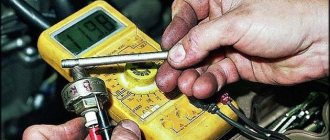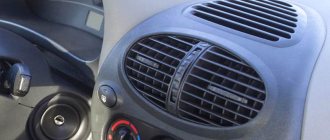High car fuel consumption
It's not nice to throw money away when your car has high fuel consumption. Those who do not trust their car to a car service try to determine the reason for the high gas consumption on their own. Others, on the contrary, rush to the service station, where the technician begins to examine the car. Why does the car consume a lot of gasoline?
In fact, increased gas mileage may be the result of not one, but several problems at once. Let's try to figure out what affects fuel consumption and whether it is possible to reduce gasoline consumption without the help of specialists:
Errors in the electronic engine control system
car electronic system sensors One of the main reasons for increased fuel consumption on modern cars is a malfunction of the engine management system. This is due to the incorrect operation of sensors that are designed for optimal calculation of the air-fuel mixture: Temperature sensors (coolant and intake manifold). Throttle position sensors (TPS). Mass air flow sensor (MAF). Its service life is significantly reduced if the air filter is not changed in a timely manner. Oxygen sensor (lambda probe). Errors in these sensors to varying degrees cause a “lean” or “rich” mixture, which is expressed in loss of power and excessive fuel consumption. All these faults are difficult to determine without diagnosing the car, but it is possible if you look for it by rebuilding the sensors.
Abnormal pressure in the fuel systemVAZ 2110 fuel system The pressure in the fuel system may be higher or lower than normal. It is a rare situation when there is high pressure in the fuel system; most often the opposite situation occurs.
Low pressure in the fuel system is what causes the engine to lose power. And on a car with an automatic transmission, it increases the engine operating time at higher speeds and, as a result, increases fuel consumption. We have already described how to determine the causes of low fuel pressure in a separate topic.
Malfunction of the engine injector, dirty car injectors. If the car owner does not monitor the condition of the engine, then over time the engine efficiency will decrease, and if started, the engine will begin to stall. The reason for this is dirty engine injectors. The quality of gasoline atomization deteriorates and normal mixture formation is disrupted. In this case, cleaning the injectors will help, which you can easily do yourself.
Faulty car catalyst
Over time, the catalyst may burn out or even partially collapse. We will not delve into the intricacies of the process, the main idea is: The more “clogged” the catalyst is, the richer the mixture. This in turn causes more heating of the catalyst, which negatively affects the durability of the catalyst. The consequence of this will be a decrease in engine power and significantly higher fuel consumption.
In addition, the cause of catalyst destruction may be: dirty engine injectors, old spark plugs, malfunctions in the engine management system or low-quality gasoline. Engine temperature Increased engine temperature The optimal operating temperature of the engine is 98-103 ° C. If the engine overheats, the fuel mixture becomes discharged. The engine starts to run on a lean mixture, which results in a loss of power.
If the engine is not warmed up, then fuel consumption will increase due to the fact that enriched fuel injection occurs (necessary for warming up the internal combustion engine). For example, if the engine temperature is 80°C or lower, then gasoline consumption increases by 20%. The reason when the engine is not operating at operating temperature lies in the engine cooling system (for example, in the thermostat).
Thus, if you only use the car for short distances, when the engine does not have time to warm up sufficiently, then the average fuel consumption will be higher than for long trips. Dirty air filterDirty air filterYes, oddly enough, but one of the reasons when a car eats a lot of gasoline is a clogged air filter. Due to the lack of air in the engine, the effect of “air starvation” begins and the operation of the mass air flow sensor is disrupted. As a result, we again see a picture where mixture formation does not occur correctly, which causes increased fuel consumption. Conclusion Low fuel consumption Now you know that if a car consumes a lot of fuel, then to eliminate the causes, sometimes it is enough to simply replace the air filter, and sometimes without proper diagnostics of the car, make do. In addition to the above, you can reduce fuel consumption by changing your driving style or using the air conditioner less often. Also, do not be surprised if the car consumes fuel when wheels are installed significantly larger than those recommended by the factory or when fuels and lubricants of inappropriate viscosity or quality are used.
Issue price: 0 ₽ Mileage: 164,400 km
Today, petroleum products, especially fuel, are becoming more expensive before our eyes, and therefore an increase in fuel consumption is the worst nightmare for any motorist. Often, the reasons for the appearance of such a phenomenon on the 16-valve VAZ-2112 are quite simple and understandable. Although, not all motorists know them and can fix the problem with their own hands.
Functionality check
Many VAZ-2112 owners ask how to check the lambda probe (oxygen sensor) themselves. To do this you will need to do the following:
- It is necessary to turn off the engine and allow it to cool.
- After this, open the hood of the car and disconnect all contacts leading to the oxygen sensor.
- Take a multimeter and connect the end probes to the lambda probe.
- Then use the “Resistance” mode on the multimeter. If the arrow goes to infinity, then the device is working correctly and the readings are being transmitted correctly.
- In a situation where the arrow shows a value near zero, the measuring device is faulty and needs to be replaced.
How to reset the error?
You can delete the error code from the memory of the VAZ control unit by disconnecting the terminal from the battery.
The reset procedure is performed as follows:
- The vehicle's ignition system is activated, but the power unit does not start.
- The engine compartment of the vehicle opens. Using a wrench, loosen the screw that secures the terminal clamp on the negative output of the battery.
- After about one minute the contact is reconnected.
- The engine compartment of the car is closed, the ignition system in the car is turned off.
- The car engine is starting. If the “Check” indicator remains lit on the dashboard, it should disappear on its own after a few kilometers.
Basic rules for reducing gasoline consumption
To eliminate increased fuel consumption, it is worth understanding the design features of not only the main power unit, but also the auxiliary systems on which the operation of the engine as a whole depends. To adjust the mixture to operating values, reduce CO_Koeff to 0 and, observing the gas analyzer readings, adjust the composition of the mixture, reducing in our case the CO_Koeff coefficient to -0.
How to determine a faulty oxygen sensor
There are a number of methods for checking the condition of the lambda sensor and its power/signal circuits. BOSCH specialists advise checking the corresponding sensor every 30 thousand kilometers, or when the malfunctions described above are detected.
- It is necessary to evaluate the amount of soot on the probe tube. If there is too much of it, the sensor will not work correctly.
- Determine the color of the deposits. If there are white or gray deposits on the sensor element, this means that fuel or oil additives are being used. They negatively affect the operation of the lambda probe. If there are shiny deposits on the probe tube, this indicates that there is a lot of lead in the fuel used, and it is better to refuse to use such gasoline, and accordingly, change the brand of gas station.
- You can try to clean the soot, but this is not always possible.
- Check the integrity of the wiring with a multimeter. Depending on the model of a particular sensor, it may have from two to five wires. One of them will be a signal one, and the rest will be a supply one, including for powering the heating elements. To perform the test procedure, you will need a digital multimeter that can measure DC voltage and resistance.
- It makes sense to check the resistance of the sensor heater. In different lambda probe models it will range from 2 to 14 ohms. The supply voltage should be about 10.5...12 Volts. During the verification process, it is also necessary to check the integrity of all wires approaching the sensor, as well as the value of their insulation resistance (both in pairs and each to ground).
How to check a lambda probe video Please note that normal operation of the oxygen sensor is only possible at its normal operating temperature of +300°C...+400°C. This is due to the fact that only under such conditions does the zirconium electrolyte deposited on the sensitive element of the sensor become a conductor of electric current
Also, at this temperature, the difference between atmospheric oxygen and oxygen in the exhaust pipe will cause an electric current to appear on the sensor electrodes, which will be transmitted to the electronic engine control unit. Since checking the oxygen sensor in many cases involves removal/installation, it is worth considering the following nuances:
- Lambda devices are very fragile, so during testing they should not be subjected to mechanical stress and/or shock.
- The sensor thread must be treated with special thermal paste. In this case, you need to make sure that the paste does not get on its sensitive element, as this will lead to its incorrect operation.
- When tightening, it is necessary to observe the torque value and use a torque wrench for this purpose.
Elimination methods
The mass air flow sensor (MAF) is considered a target device for detecting fuel loss. A machine with the sensor disabled may perform well. This agility is the beginning of the end of the mass air flow sensor. The device is turned out and the voltage is checked with a tester (the ignition is on).
Checking the mass air flow sensor
Based on the individuality of each car, the voltage should not exceed 1.03 V. Otherwise, the sensor is replaced. A VAZ-2110 with a volume of 1.6 liters and a speed of, for example, 2000 requires about 25 kg of air. Therefore, as this value increases, gasoline consumption increases. Hence the priority of diagnosing the air flow sensor.
- A faulty fuel system simultaneously increases the level of harmful emissions into the atmosphere, reduces power, and turns off the engine when idling. The situation requires checking the fuel pressure supplied to the injectors using a pressure gauge (preferably with a 7-fold division range).
- The gasoline filter is dirty and needs to be replaced. A clogged air filter increases consumption by almost a third of the standard.
- Weak compression, the elimination of which will lead to disassembling the engine, replacing the piston rings, crank - connecting rod mechanism, checking spark plugs, breakdowns of high-voltage wires. Incorrect ignition angle setting also negatively affects gasoline consumption.
Overspending is accompanied by:
- Coolant temperature. A defect in this sensor results in a “lean” or “rich” fuel mixture.
- A malfunctioning throttle clamp sensor directly affects the idle speed and throttle response of the vehicle.
- A defect in the forced air device negatively affects the balance of the mixture (air - gasoline).
- A vacuum and air flow sensor monitors mixture formation.
- Oxygen sensor giving incorrect mixture ratio.
- Reduced fuel pressure leads to a decrease in power and a deterioration in the acceleration qualities of the car. This factor indicates that the fuel pump is worn out or the filter mesh is clogged.
- Dirty injectors and carbon deposits on them lead to distortion of the flame contour and, as a result, poor atomization. This fact of poor-quality mixture formation increases fuel consumption, reducing the vehicle's throttle response.
- Malfunction of the ignition circuit (coil, spark distributor, GDP).
- A dirty air filter cannot produce the correct proportion of incoming air.
Technical characteristics of the car: Engine VAZ-2110 15l 72 hp
1 at an engine speed of 750-850 it should consume 7-8 kg of air per hour, if the values are lower, then this may already indicate wear of the cylinder-piston group; the lower the reading, the greater the wear. Since recently all my weekends began to be spent in the garage, I gave up on this thankless task and sold it cheap to my son - let him work with it.
| Name | Index |
| Brand | |
| Marking | 1.6 8V |
| Type | Injector |
| Fuel | Petrol |
| Valve mechanism | 8 valve |
| Number of cylinders | |
| Fuel consumption | 9.6 liters |
| Piston diameter | 82 mm |
| Resource | 200 – 250 thousand km |
Doesn't show fuel level AT ALL
When the arrow points to “0” with a full tank, then attention should be paid to all contacts and connections:
- First of all, this concerns the bolts located on the back side of the instrument panel, since they are the ones who create contact by fixing on the indicators.
- It is possible that the fuel level needle has lost its position and needs to be adjusted.
- The instrument panel itself may also be faulty. Since its mechanical parts are very susceptible to wear.
- We test all the “negative” wires, especially the one located near the handbrake. Because often it is he who is promoted.
- The float or the FLS itself is jammed.
Please note that if you have an on-board computer (not older models - approx.), it is possible to control the fuel level electronically. It is enough just to enter the readings, after each refueling of the car and the faulty FLS arrow will no longer bother you
Welcome! Fuel level sensor - thanks to it, you can find out at any time how much fuel you have left in the gas tank; if you didn’t have it or if it had become unusable, then checking the fuel in the tank becomes much more difficult and inconvenient; you would have to live without it you would have to unscrew the cap of the gas tank and poke some kind of stick into it to find out how much gasoline is left in it, but on modern cars the gas tank generally goes to the very bottom (all front-wheel drive cars do this) and gasoline is poured into it through a tube that comes from the top and connects to the tank.
Note! In order to replace the fuel level sensor, you will need tools, namely: Wrenches to unscrew the nuts securing the fuel pipes, you will also need a screwdriver, and we also recommend stocking up with a rag to wipe off gasoline that gets on you and we do not recommend that you smoke while working or use fire (a lighter, for example)!
- Replacing the fuel level sensor and checking it
- Additional video clip
Where is the fuel level sensor located? It is located in the gas tank itself, or rather, it is one piece with the gas pumps and therefore you won’t be able to see it so easily, let’s start first with the fact that, as we said earlier, the gas tank is located at the bottom, it is located on front-wheel drive cars immediately under the rear airbag seats, so in order for you to be able to see the fuel pump inside of which the sensor itself is located, you will have to first fold back the rear seat cushion and only after that unscrew the two screws that secure the cover (This cover will be discussed in another article to which a link will be given as you read) you will see the location of the fuel pump (It is circled in red), and you will need to remove it.
When do you need to change the fuel level sensor? It must be replaced when the fuel level readings become incorrect, that is, if the fuel level arrow does not show (Although there is gasoline in the tank), and also if the arrow shows completely incorrect readings (Although this can be corrected, in this case the sensor is most likely bent the lever that holds the sensor float is in the wrong direction) and even if ringing the wiring does not give you anything (we will tell you how to test the sensor wiring in the same article, so stock up on ohmmeters in advance) then the sensor also needs to be replaced.
Knocks
The pistons for 124 engines have an improved design, thanks to which the valves do not bend. Piston rings made of cast iron or steel. The pistons are connected to the connecting rods using pins that have a floating connection and are secured with retaining rings. The connecting rods and fingers are taken from the VAZ 2110 model.
16 valve version
Further improvement in engine performance was possible by installing turbocharging or switching to a BC head, where the number of valves was doubled.
Oxygen sensor VAZ 2112
The lambda probe is installed in the exhaust system. Sensors are divided into two types: two-point and broadband.
The two-point sensor consists of ceramics, the elements of which are coated with zirconium dioxide on both sides. Installed in front of or behind the catalytic converter. The principle of operation is to measure the level of oxygen concentration in the environment and exhaust gases. If the level changes and becomes different, a voltage is created at the ends of the sensor elements, from low to high. Low voltage is created if there is excess oxygen in the system. Otherwise, if the system does not have the required level of oxygen, high voltage will be created. These signals are sent to the engine control unit, which distinguishes them by current strength.
How to check
Connect the adapter and run the engine at 2000 rpm. To ensure that the oxygen sensor remains hot throughout the entire measurement cycle. Do not disconnect the sensor connector to avoid disrupting the full feedback cycle in the fuel injection system. Connect an oscilloscope to the oxygen sensor signal lead. Be careful, there are heated sensors (three or four wires). In this case, you need to connect to the signal wire. An oscilloscope will show you waveforms of your sensor's performance and give you an idea of the signal levels in the signal chain.
Before taking measurements, check the scale marked on the measuring tool. It must be correct. A properly working oxygen sensor will show you a signal,
Malfunctions
A modern lambda probe installed on a VAZ has 4 outputs: ground, signal output and two for the heater.
The lambda probe readings are best read with special software by connecting to the diagnostic bus of your car. This is the only way to know the waveform it produces and the rate of change of these signals. First of all, when diagnosing the sensor, remove the connector from it and use a multimeter to check the presence of voltage on the signal wire from the ECU; it should be 0.45 volts. By the way, if this voltage deviates from the given value, most often in the direction of increase. This can be cured by installing an additional resistor. You can calculate the required resistor value as follows:
1) take an adjustable resistor, such as for volume control
2) We connect it in series to the lambda signal power circuit.
3) connect the tester and twist the resistor until the voltage reaches 0.45-0.46 volts.
4) start the car, check, if everything is OK, measure the resistance on it and select a regular resistor of the appropriate value. By the way, the resistor will not heat up; there is no high load.
1) First, remove the “-” terminal from the battery, using a wrench to loosen the nut that holds this terminal. (How to loosen the nut and then remove the terminal from the battery, read the article: “Replacing the battery”, in the “first” paragraph)
2) Next, find the second end of the wiring harness, which comes from the oxygen sensor and connects to the block, and after finding it, disconnect them from each other.
Note! To make it easier for you to find the second tip of the wiring harness and block, in this case, start your search from the first tip, which is installed in the exhaust pipe of the car!
3) After disconnecting the second tip, move to the first, which is located in the exhaust pipe of the car, and then, using a wrench, completely unscrew the nut that secures it.
Unscrewing the sensor nut using a wrench
4) And after unscrewing, remove the sensor from the car.
1) First, install the first tip of the new oxygen sensor in its place, and after installation, tighten the nut securing it until it stops.
2) Then connect the second end of the wire harness to the block.
3) And at the end of the operation, using the same article on “Replacing the battery”, install the “-” terminal on it in the reverse order of removal.
Important! When replacing the sensor, if the car's engine is hot, then try to work with thick gloves, or wait until the engine cools down to a cold temperature, because when the engine is very hot, the exhaust pipe and the oxygen sensor itself become very hot, their temperature rises to about 360 °C, and therefore when replacing the sensor, protect yourself and your hands from burns!
How to repair a fuel level sensor with your own hands
Repairing the fuel level sensor is quite affordable for the average car enthusiast. Parts of the device can be freely purchased at an automobile parts store. It is necessary to remove the sensor from the tank and study its characteristics. The marking is located on the front side of the plate directly above the rheostat scale.
If the float is broken, then this is the least of the problems. They change simply. Usually, this is a plastic barrel filled with air; it is simply removed from the holder socket and a new one is inserted. Sometimes this is a porous element and can be replaced in two ways. Remove the locking washer and put on a new one, securing it. Or change the float assembly with the rod, which is much simpler.
If the rheostat scale strips are dirty, you just need to clean them.
Attention! The record should only be cleaned with a soft cloth or cotton wool soaked in alcohol. Hard matter or any other object can damage the thin layer of the scale and the rheostat can be thrown away. Unsoldered or torn wires can be carefully soldered in place or soldered at the fracture site, but a cracked, broken plate can only be replaced with a new one
Unsoldered or torn wires can be carefully soldered into place or soldered at the fracture site, but a cracked, broken plate can only be replaced with a new one
Unsoldered or torn wires can be carefully soldered into place or soldered at the fracture site, but a cracked, broken plate can only be replaced with a new one.
In most cases, no one suffers from this now. A non-working device is replaced and that’s it. Fortunately, their price is low. Moreover, on cars of recent years, the rheostat plate, and all other parts of the device, are secured with latches.
Inaccurate indicator readings can be deceived by adjusting the angle on the rod holding the float. By bending it in different directions you can ultimately achieve more accurate readings.
First of all, we can mention the electronic display for the instrument panel. It is installed together with a standard dial fuel level indicator on a panel in a free cell or directly on the torpedo. Three wires are output, “+”, “-” and “D”. The latter is connected to the sensor along with the standard device. On the sensor removed from the tank, the level readings are adjusted in digital format, from “empty” to “full tank”. This does not add any particular accuracy to the readings, but it does give a stylish look to the instrument panel and warms the owner’s soul. Signs are used in various shapes and it is quite possible to choose a sign to match the interior design of your car.
A completely different matter is the novelty in this matter (relative) - ultrasonic fuel level sensors. Here, as in most devices, the principle of receiving and transmitting ultrasonic waves is used. The sensor can be installed in the tank without violating its integrity. The signal can be transferred to a digital monitor on the instrument panel and even output to a computer or laptop via the GLONASS system. Today this is the most accurate way to obtain data on fuel level. However, this is still a rather expensive procedure, which also requires special knowledge and skills to calibrate the ultrasound emitter and specialized programming equipment. However, everything suggests that meters of this type will be widely used in the future.
In the video below you can see the replacement of the fuel control sensor on a VAZ Priora car:
conclusions
There are many reasons for increased fuel consumption on the 16-valve VAZ-2112 engine. So, finding the causes and eliminating them can take from several hours to several days. If the motorist is not sure that he is able to cope with this problem, then it is recommended to contact a car service, where they will do everything quickly and efficiently.
When buying a car, the owner is interested in the question of fuel consumption. The fuel consumption of the VAZ 2112 16 in comparison with other models of this car brand is considered economical and acceptable. But it is worth considering that even the driver depends on gasoline consumption for a certain distance. To understand this issue in more detail, it is necessary to consider all the reasons and nuances that affect the decrease or increase in fuel consumption. The actual fuel consumption of the Lada 2112 in the city is approximately 8 liters per 100 kilometers.
If your car's engine uses more fuel, then you need to find out all the direct factors that influence this.
Causes of a lean mixture
The error shows that the mixture is lean
How to determine the problem of the occurrence of a lean mixture effect in the engine cylinders? There are several reasons why this process may occur. So, let's look at all the possible options:
- The reason lies in the electronic control unit.
- Sensors and electrical equipment.
- Fuel system.
- Throttle valve and air filter.
- Ignition system.
Now that all the reasons have been considered, you can move directly to elimination methods.
Making a poor mixture into a good one!
To eliminate the causes of a lean mixture, you will have to work hard, since there are quite a lot of components in which a malfunction could occur. It is worth considering the sequence of actions to find the problem area and eliminate the cause.
Problems in the ECU
The first place you need to look is the electronic control unit of the engine and its systems. Thus, the accumulation of errors in the ECU can lead not only to changes in the mixture, but also to other malfunctions. In order to eliminate the cause, you need to connect to the unit using a USB-Auto cable and look for any faults. Often, this is where the initial answer to the question lies. This or that error will show which node caused the malfunction. As practice shows, this may be one of the sensors.
Diagnostics of the ECU for errors
If, however, a large number of errors are detected during connection, then a reset is necessary. If it does not help, and the sensors are all working, then motorists recommend reinstalling the car software. It depends on the type of control unit that is installed on the vehicle.
Sensors and electronics
Failure of one of the sensors can result in a lean mixture. So, exactly what indicators need to be checked for performance in engines:
Mass air flow sensor
The IAC sensor is located on the throttle valve
Throttle position sensor
It is also recommended to check the wires that go to the sensors for breakdowns. If necessary, damaged elements must be replaced and the error reset procedure repeated.
Fuel system
One of the main systems that leads to a lean mixture is the fuel system. The main reason is insufficient pressure in the fuel rail. This may be due to several reasons:
Computer diagnostics of cars
Thanks to this method, you will be able to identify the reasons that lead to high use of gasoline.
Sometimes it is impossible to clearly identify them, but the computer shows the entire condition of the car as a whole, as well as the condition of the main parts that directly affect the fuel consumption of the engine. If you find an error, please select a piece of text and press Ctrl+Enter.
Didn't find the information you are looking for? on our forum.
In 1999, AvtoVAZ introduced a five-door version of its VAZ-2110 sedan, which received the factory index VAZ-2112. Due to the fact that the length of the body was slightly shortened, the car became more controllable and maneuverable, while the volume of the luggage compartment was increased due to the modified shape of the rear part and amounts to 400 liters. With the rear seats folded down, its volume almost doubles.
Production of the model continued until 2008, after which the VAZ-2112 was replaced in production by the five-door version of the Priora. Four versions of the “twelfth” model were produced, differing in engines and power.
Since 2001, VAZ-2112 cars in the VAZ-21120 version have been equipped with a VAZ-21120 injection 16-valve engine with a volume of 1.5 liters. This engine developed a power of 92 hp.
With. and a torque of 133 Nm and was considered one of the most popular engines in the LADA 110 family. The engine was paired with a 5-speed manual transmission.
Location and service life of the controller
On a VAZ-2112 with engines with 16 valves, the measuring device is located at the exhaust pipe, between the exhaust manifold and the coupling. To replace the device, you must gain access to the underbody of the vehicle body. For the best convenience, you need to drive the car into a garage with a pit or drive onto an overpass located near the highway.
The service life of the oxygen sensor may vary. If a motorist uses a high-quality fuel mixture, the service life will be up to 110 thousand kilometers. In the case when a low-quality mixture is used, the service life is reduced to 85 thousand kilometers.
Which engine is better 124 or 126
Many drivers are happy to call the engine of a modern car the heart of the car. Naturally, when buying a new car, every user asks the question of whether the basic technical characteristics and operational parameters meet the requirements. There is increased interest in two main parameters, which can roughly be called:
- Strength (power, thrust, etc.).
- Longevity (nominal service life, ability to withstand high operating loads).
Most often, motorists who prefer equipment from domestic manufacturers compare the power units used on the Lada Priora. And the main question is: which engine is better, 124 or 126? Let's try to figure it out!
Oxygen sensor
For some reason, it is quite difficult to find code 0525 in the decoding tables, but this is simply an error in the oxygen sensor, otherwise called a lambda probe. And if you see 0525 on the display again, it means that not everything is in order with the oxygen content in the exhaust.
This sensor is not installed on all VAZ models; it sends a signal to the engine regarding how much oxygen should be in the fuel system. That this sensor does not cope with its duties is evidenced by:
- increased fuel consumption;
- unstable work at XX;
- loss of power, lack of "response".
New Bosch lambda probe
In principle, the lambda probe should be changed after about 60 thousand mileage, but this can happen earlier, especially considering the quality of our gasoline. Therefore, it may display 0525, warning that it is time to replace the oxygen sensor.
Engine lubrication system 126
This engine solves the problem of 16-valve engines, the VAZ 21124 engine does not bend the valve, for this there are holes on the bottom of the piston and with standard shafts or sports ones with moderate lift, the owner has nothing to fear. Troubling of the monitored engine at idle speed often appears due to clogged fuel injectors, faulty coils and or spark plugs.











